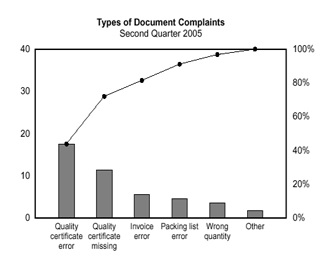A pareto chart is a special type of bar graph, which incorporates the use of a line graph to represent the cumulative total of all the units being measured. A pareto chart is similar to a bar graph in how it uses vertical bars to record frequency or a specific quantity such as cost or time. However, this figure differs from a basic bar graph in terms of organization, since in many cases the bars are in consecutive order with respect to bar length (longest to shortest), includes a line graph and has two labelled y-axes.
The principle behind a pareto chart is based from Pareto’s empirical law, which states that “any assortment of events consists of a few major and many minor elements” (1). Basically, a pareto chart provides a useful way to analyze the significance of different issues or problems. By presenting the data in terms of their order of frequency, this allows for the few major elements to be emphasized.
The use of a pareto chart is particularly effective when trying to pin-point the most powerful or significant issues facing a process. Just as Pareto’s empirical law says, often there is a multitude of issues taking place, but in many instances, only a small number account for over half the total frequency (1). Below is an example of a pareto chart (2).

Figure 1. This figure provides an example of a pareto chart modeling the frequency of different types of document complaints. By analyzing the figure, it is clearly evident that quality certificate errors and quality certificate missing issues represent the highest percent of complaints. The line graph represents the cumulative total of all the complaints and corresponds with the right-handed y-axis. This figure has been taken directly from: http://asq.org/learn-about-quality/cause-analysis-tools/overview/pareto.html.
As can be seen from the above figure, pareto charts represent an effective method of identifying the major issues hindering a process. By modeling data using a pareto chart, a business manager or company worker can learn which issues need to be eliminated from a system in order to make a process more effective.
References:
1. Miller, I and Freund, J. (2011). Probability and Statistics for Engineers – 8th Edition. Pearson Education, Inc.: U.S.A.
2. http://asq.org/learn-about-quality/cause-analysis-tools/overview/pareto.html
